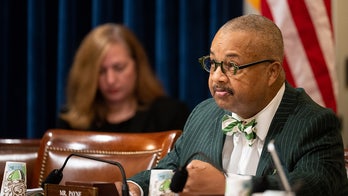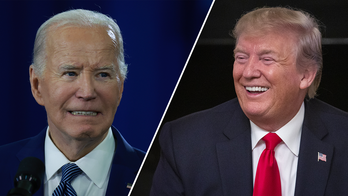Japan Nuke Disaster Squelches Hopes for U.S. Energy Deal
“I think we've got to kind of quietly put, quickly put the brakes on until we can absorb what has happened in Japan as a result of the earthquake and the tsunami and then see what more, if anything, we can demand of the new power plants that are coming on line."
-- Sen. Joe Lieberman on “Face the Nation”
Every path to political compromise on a U.S. energy policy runs through nuclear power. And no matter how serious the problems at the quake-ravaged Fukushima Dai-ichi reactors in Japan turn out to be, the situation there has likely snuffed any hopes of a deal on energy until at least 2013.
President Obama’s embrace of nuclear power last year in the form of an $8.3 billion in loans to Southern Company to build two new nuclear reactors had produced a small but durable hope on Capitol Hill that energy policy might be the vehicle for some grand bipartisan compromise ahead of the 2012 elections.
Obama still opposes a nuclear waste storage facility in Nevada and only gave Southern Company the nod because of their aggressive support for his overall anti-global warming agenda, but the president’s pivot on nuclear power was one of the few areas where Republicans detected a genuine change, rather than forced acceptance (such as on Guantanamo Bay or extending the Bush tax rates).
With Obama also bowing to the reality that his proposed program of global warming fees to be paid by businesses was dead in the new, divided Congress, many believed that the moment was ripe for an energy compromise. Sen. Lindsey Graham, R-S.C., whose home state is set to get one of the Obama-financed reactors, has been trying for months to broker a deal.
Republicans are generally more supportive of nuclear power than Democrats, and by giving a nod to a plan for 20 new reactors to be built over the next 20 years, Obama was opening the door to a deal. And such a plan would have been very ambitious, since it generally takes more than 20 years to bring a new reactor into service.
Granted, much of the construction would have been dedicated to replacing the 104 aging reactors currently online, but the plan would have provided lots of new, domestically produced megawatts without any new carbon emissions. Both sides could have declared victory.
But with new public anxiety about nuclear power in the wake of the slow-motion meltdown horror in Japan, that’s not going to happen.
Just as Obama’s tentative embrace of offshore drilling in the spring of 2010 was undone just weeks later by the massive explosion on BP’s Deepwater Horizon rig in the Gulf of Mexico in April 2010 so too will the administration and compromise-oriented Democrats in the Senate be turned away from nuclear power expansion.
It also casts doubt on the permits for the two new reactors planned under the Obama loans.
To understand the havoc short-term safety concerns can have on long-term nuclear projects, consider the next reactor expected to come online in the nation (and the only one currently under construction).
Construction on the second unit at the Watts Bar nuclear plant south of Knoxville, Tenn. began in 1973.
While Three Mile Island in 1979 had set the tone for anti-nuke activism, successive scares made the idea of nuclear power politically unappealing. The tipping point came in 1986 with the Chernobyl disaster. Chernobyl came just two weeks after a major scare Boston Edison’s Pilgrim Plant, and reconfirmed American fears about meltdowns and hazardous waste.
After 13 years under construction, the Tennessee Valley Authority finally halted construction on Watts Bar Unit 2 in 1988 amid protests. But the following decade saw a decrease in nuclear scares and a growing comfort level with nuclear power amid escalating fears of global warming on the left.
The Watts Bar project was resumed in 2007 and is slated to come online sometime in the next two years.
If a government agency needs 40 years to complete a reactor next door to an existing one, how probable does it seem that 20 new reactors built by private companies will power up by 2030?
Regardless of the science and comparative risk, the Japan disaster will stifle the American acceptance of nuclear power and, by extension, kill the chance for an energy policy compromise in Washington.
Fiscal Aftershock from Japan Disaster Heading for U.S.
"I don't think we can take for granted that the bond markets will take things in stride in the current fiscal environment."
-- Economist Maurice Obstfeld of the University of California, Berkeley to the Wall Street Journal
Despite the devastation in Japan, investors seem to believe that the country’s economy will endure the shock of more than 10,000 dead and massive industrial disruptions caused by failures at key nuclear power plants.
While Japan’s stock market tumbled and led a round of sell offs around the region, the downturn was offset by investors jumping in to grab stock in construction firms that will benefit from a massive rebuilding effort.
But damage from the disaster is already seen at close to $200 billion and climbing as radiation worries spread across the northern part of the country. That means Japan, which was already in a worse credit crunch than the U.S., will need to raise lots of capital very quickly.
That presents a serious problem for America.
The interest rate that the Treasury must pay to borrow money ($223 billion in February alone, the most ever for a single month) has been held down by two factors – the comparative attractiveness of American debt compared to that of fiscal basket cases in Europe and elsewhere and the aggressive move by the Federal Reserve to print money to gobble up debt and keep interest rates low.
Well, international investors were already souring on American debt owing to the political conditions in Washington that seemed to make substantive action on long-term debt unlikely.
The Federal Reserve’s cash dump is slated to end in June, which will dramatically reduce the demand for U.S. bonds. Without Ben Bernanke buying them, Secretary Tim Geithner will have to offer lenders higher rates of return to accept U.S. debt.
That was expected, though the retreat of international investors was certainly stoking fears that interest rates were going to climb quickly. The concern is that as U.S. interest payments increase, so does the debt, which in turn heightens fears of more currency shenanigans by the Fed in order to pay off the debt with cheap dollars.
The Japan crisis will further fuel fears about a vicious circle on U.S. debt. Japan owns more than $882 billion in U.S. – only three quarters as much as China, but almost four times more than the next closest country, Britain.
Japan was already having considerable trouble borrowing money prior to the earthquake, and bond buyers will make the country pay a premium to raise huge sums of emergency cash to rebuild its infrastructure.
One way Japan will raise that money is by selling off its holdings in U.S. bonds, how big the sell off is unclear, but it will be something. But Japan will also certainly curtail its debt buying for a period and focus on selling its own bonds.
Japan’s situation will decrease demand for U.S. bonds and create a higher-return competitor at the same time.
Coming as investors give Washington a thumbs down on fiscal restraint and as the Fed winds down its cash pumping, Uncle Sam could soon be paying much higher interest rates on its ever-mounting debt.
Obama and Petraeus Talk Afghan War, But Pakistan Looms Larger
“I can announce that we are coming to the street with 4,000 armed students. What can the government do?”
-- Pakistani Muslim cleric Yousaf Qureshi, who has offered a bounty for the killing of Christian women and praised the work of Islamist assassins, discussing his government salary with the Washington Post
President Obama this afternoon will meet with his commander in Afghanistan, Gen. David Petraeus as part of an ongoing administration review of its strategy in the war-torn country.
While Petraeus will have much good news to report about American gains in key portions of the nation and can offer Obama a plausible scenario for a 2014 exit strategy, events across the border in Pakistan continue to overshadow the incremental advances being made by allied forces.
Today, a Pakistani court will reconsider the case of Raymond Davis, a CIA contractor traveling under a diplomatic passport, who has been charged with the murder of two young men in Pakistan. Davis says he was defending himself in a robbery and the Obama administration has pointedly called for Davis to be released.
But Pakistani President Asif Ali Zardari knows that if the court complies, his government will quite possibly be toppled. Terror attacks have risen sharply in recent months and the threat of an Islamist uprising hangs over the country.
The nation is quickly radicalizing, having recently established the death penalty for any Christian caught proselytizing and seen the killers of high-level opponents of the law treated as heroes in the streets.
One of the central grievances among the masses is Zardari’s support for the CIA-led drone war against Islamists hiding out in the mountains of western Pakistan. The mission, considered crucial to preserving gains made by Petraeus’ forces in Afghanistan, is despised by Pakistanis. And agency man Davis has become the personification of the effort.
But if the court proceeds with the murder case against Davis it will be evidence that Pakistan is no longer able to function even nominally as a U.S. ally. If Zardari cannot deliver Davis, his ability to protect U.S. interest to any degree will be highly dubious.
If Pakistan is falling apart with the best case scenario being the return of a military junta at least somewhat allied with Islamists, any Obama strategy for Afghanistan will be cast in serious doubt.
Libyan Rebels Failing
“We can wait until they impose a no-flight zone. If they don’t, what can we do, my friend? We fight and die. God is with us, God willing.”
-- Said Zway, 29, a civil-engineer-turned-rebel soldier, talking to the New York Times at Ajdabiya, the last redoubt of the resistance
The better-armed, better-organized forces of Muammar al-Qaddafi are turning back the rebel forces in Libya.
Hampered by an arms embargo and comprised of an uneasy coalition of tribesmen and Islamists, the rebel forces have lost control of key oil sites and are now in danger of being surrounded by the pro-Qaddafi columns.
But the Arab League has now joined the rebels in calls for a Western-led no-fly zone over the country to keep the colonel’s air force from finishing the job. There is still no talk, however, of lifting the U.N. arms embargo to allow weapons to flow to the rebels (a la Reagan in Afghanistan and Central America 25 years ago).
Secretary of State Hillary Clinton is in Paris for meeting of the foreign secretaries of the eight largest economies. The discussion will certainly involve testing China’s appetite for Libyan intervention.
Beijing is usually not down with the idea of foreign intervention against repressive dictatorships – bad precedent and all that. But some limited approval might let Clinton take the case to the U.N. for some kind of action beyond sympathetic non-engagement.
And since the Obama administration is adamant that U.S. not take the lead on Libya, that means added time in finding an Arab partner that will not just call for U.S. strikes, but send its own jets. That looks all but impossible.
Whatever happens, it looks increasingly unlikely that the Libyan rebellion will last as long as the diplomatic bickering about it.
Uneasy Compromise on Spending Already Fraying
“We're on a path, a slow path, but a path nevertheless to get to the $61 billion in reductions of this year's spending that House Republicans were able to send over to us.”
-- Senate Minority Leader Mitch McConnell, R-Ky., on “FOX News Sunday”
There is a widespread belief that the House and Senate will soon agree to a three-week spending plan to keep the government operating past the current Friday deadline.
Having fashioned the $6 billion in cuts from the modest proposal put forward by Senate Democrats, House Republican leaders found a receptive audience in the upper chamber.
And while the next round of cuts would keep the government on track for the House GOP’s target of cutting $61 billion from March 4 to Sept. 30, anxiety about the kick the can approach is growing on the right.
If a deal moves the deadline to April 8, Democrats will have increased leverage as a vote over the administration’s demand to raise the nation’s $14.3 trillion borrowing limit.
Senate Democrats have seized on a rope-a-dope strategy. By accepting a total of $10 billion in cuts, Majority Leader Harry Reid and his team must believe they can smash the House Republican caucus by forcing a collision of difficult votes on a final fiscal year spending plan and the debt ceiling vote.
Speaker John Boehner will face serious resistance on both issues and Reid may be able to cause a breakdown between conservative House members and the Republican leadership by stacking up the votes.
Senate Democrats also know that the less time there is left in the fiscal year, the harder it will be for Republicans to deliver debilitating cuts. A three-week stopgap measure would leave less than half of the budget year and might give organizations like National Public Radio and Planned Parenthood a chance to wriggle out of Republicans’ clutches.




